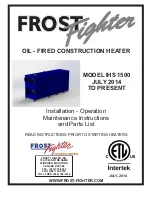
- 4 -
4.2
Decide upon the route for the
gas supply and if this is to be a
concealed supply, select a
suitable hole in the fire box,
remove the knockout and lay
in the supply as required. Fit
the rubber grommet around the gas pipe entry to the appliance and seal.
Before
working on pipework, plug the ends to prevent the entry of debris. Decide upon the route
for the gas and lay pipework as required. If the gas pipe passes through a wall, cavity or un-vented
void then there should be no joins in this area and the pipes should be fully sleeved.
Note the supply can be either concealed through the holes in the appliance sides and back or
surface fitted over the hearth and where pipes pass through walls they must be sleeved. In the
case of remote control fires and wall mounted fires, all of the possible gas supply positions may
not be available. Before pushing gas pipes through walls, seal the pipe ends to prevent debris
entering the pipes.
.
Before
connecting any pipes to the appliance, fully purge pipes of debris or swarf etc. and connect
the gas supply to the 8mm elbow on the fire. Leak test the supply using an approved method.
Note: An isolating valve must be situated near the appliance for servicing.
5.0 INSTALLATION INSTRUCTIONS
Note: The fires must be used as supplied with the smaller 60mm spacer fitted, failure to do so
will make fitting the decorative case impossible & may overheat the fireplace and thus
invalidate the warranty. Burley manufacture purpose made surrounds, which have been
specially tested with the appliance for compatibility. The following guidelines must be adhered
to.
The hearth must be a minimum of 12mm thick with the top surface standing a minimum of 50mm
above surrounding floor level or surrounded by a raised fixed fender of 50mm high. The hearth
must extend a minimum of 100mm in front of the fire bed and 50mm either side of the appliance
giving an overall width of 732mm.
Closure plate tape and foam seals are unsuitable for fixing and sealing the fire into place. Always
fix with the fixing cables, the wall brackets or through the base of the fire.
5.1
INSTALLATION METHODS
The appliance is a flueless visual flame heater designed to be installed in a number of ways, both
freestanding, inset and wall or hearth mounted. This provides a great deal of flexibility. It can also
be fitted without need for a fire surround or back panel, provided it is fitted against a non
combustible surface. Any combustible materials directly behind the fire frame or back panel must
be removed and replaced with suitable non combustible material such as superlux board, cement
or similar.
The fire surround, back panel, hearth and all paints / lacquers etc must be of minimum 150
o
c
rating. Please ensure this is the case and if necessary check with the manufacturer, as we cannot
be held responsible for subsequent damage.
Note that paint and wall coverings on surfaces subject to heat can discolour and great care should
be taken when choosing wall coverings.
5.2
METHOD ONE - FREESTANDING ON HEARTH OR WALL MOUNTED FULLY OUTSET
This method allows for surface / wall fixing of the fire using the deep spacers and deep brackets
supplied without the need for insetting into a fire opening. The appliance gets very hot and could
cause burns therefore if wall mounting without a hearth then care should be taken to avoid
gangways and congested areas. Care should also be taken with curtains and soft furnishings to
ensure there is no possibility of them touching the appliance.





































